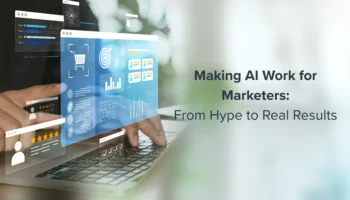We live in an always-on world — even more so now that we’re spending more time at home (and on our devices) as consumers. This means customers are also leaving behind more data — in fact, the average person generates 2.5 quintillion bytes per day. So marketers not only have to contend with crafting compelling messaging that’s worthy of customers’ clicks, but they also have to understand data science and analytics to get that job done.
Key Takeaway: At MarTech 2020, data and what to do with it, was a big theme. Marketers can expect data-centric solutions that put the customer first like CDPs to continue to be top of mind into 2021 and beyond.
Marketers are also increasingly involved with creating the overall customer experience which requires that traditionally “non-marketing” channels be involved in a cohesive, personalized style of omnichannel marketing. To learn more about this change you can continue your reading over at Forbes.com.
All of this culminates in a fantastic customer experience. But that experience is reliant on the first-party data you own to deliver a seamless experience across all channels and touchpoints, with messaging and content (like recommendations) being personalized to the individual, all at scale. Sounds daunting right? While this type of customer experience isn’t going to happen overnight for brands, there are key strategic tech investments marketers can make to get there.
One of these tools at your disposal comes in the form of a SmartHub CDP. This new category is easiest to understand if we break down its name.
- First things first, the SmartHub CDP at its core is a Customer Data Platform (but it’s a far cry from a traditional one). It can ingest and unify your first-party data (such as transaction, CRM, and browsing data) to create a Single Customer View for each customer. Marketers can access a single customer view for each customer, such as age, behavioral patterns, past purchases, and more — customer data is the “fuel” for your entire tech stack.
- Picking up where the CDP left off, the Smart component is the “steering wheel” of the stack and it guides the rest of the platform with AI-powered real-time decisioning to deliver the best possible experience to customers in real-time.
- The Hub is the “engine” of your stack — it routes data, triggers messages, and connects all the touchpoints of the customer journey
Let’s hear from someone who has successfully executed this transformation with the help of Blueshift’s SmartHub CDP: Houman Akhavan, CMO of CarParts.com.
“As one of the fastest-growing automotive parts websites (with over 10 million visits a month), it’s important to offer that 1:1 experience that will set them apart. With the SmartHub CDP, they do just that — just this year alone they’ve generated over a quarter billion personalized messages through Blueshift.”
“And I really appreciate that I’m here discussing the changing rules of marketing. I believe that the data-driven marketers that truly understand the convergence of marketing and technology will be the ones that are successful in the coming years — and ultimately are the CMOs of the future.”
“We landed on Blueshift when we were having difficulties using our data, scaling, and personalizing. Additionally, we had very little insight into our marketing — so we sought out platforms like the SmartHub CDP that would help us truly understand our customers and allow us to be “customer-first”. This is so important for our customers, they’re completely unique shoppers (you shouldn’t ever market Honda parts to a Toyota fanatic). I think it goes back to the “customer is always right” but digitally, they don’t just freely give our their preferences, but we can understand them through the data they leave behind and deliver the right message, on the right channel, at the right time with the SmartHub CDP.”
Theme: In the past 5 years customers have become super-browsers, they constantly jump across different channels, but expect a seamless experience. Marketers need to embrace a customer-centric (rather than a channel-centric) approach in marketing to execute a winning customer experience.



